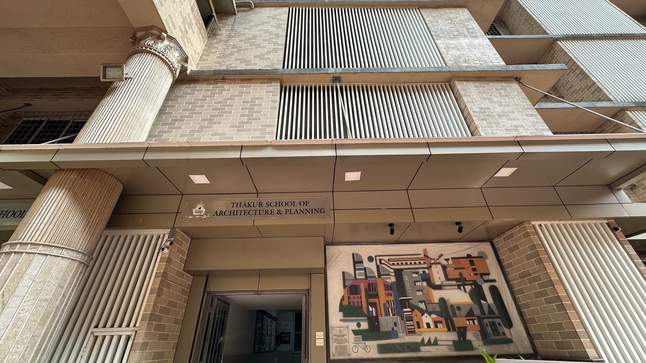
Architecture is not about pencil marks on paper. It’s a matter of building places in which people reside, work, recover, and connect. Each line, every material, every design decision has meaning—and obligation. At Thakur School of Architecture and Planning (TSAP), students are learning more than how to draw plans; they are being formed as architects able to address real-world issues with imagination, poise, and intention.
TSAP’s curriculum is not meant to work solely from textbooks. It makes students move into real sites, work in an interdisciplinary fashion, and address issues that architects face in the current complex setting. This is how the program trains students to become ready architects to design the future.
Learning by Doing: Studio Culture That Mirrors Reality
At TSAP, the walls of the classroom are only the starting point. Students immerse themselves in authentic projects where each choice counts. Whether they’re working on designing a community centre or drawing up proposals for environmentally friendly houses, students are invited to work with actual site limitations, budgets, client requirements, and environmental issues.
This hands-on method emulates the working process of the professional practice. Students are taught that design is not merely about looks but about reconciling creativity with function, safety, and context. The studio setting encourages experimentation, critiques, and iteration—the same process architects go through when they are tackling intricate projects.
Integrating Sustainability from the Start
One of the greatest challenges architects have nowadays is designing for a climate change- and resource-constrained world. At TSAP, sustainability is not a topic that is added on—it is integrated into the curriculum.
Students learn how to responsibly choose materials, minimize energy usage, and include natural systems in their designs. Assignments delve into solutions like rainwater collection, passive cooling, and renewable energy systems. Through learning holistically, students gain the attitude required for developing robust and sustainable designs that enrich people and the world.
Exposure to Cutting-Edge Technology
The equipment that architects work with has changed immensely. From 3D modelling to virtual reality walkthroughs, technology plays a critical role in bringing ideas into the real world. TSAP makes sure students are proficient in the newest software and methods of the industry.
But technology isn’t learned as a discrete discipline. It’s woven into the design process so students know how to convey ideas, check structures, and develop concepts effectively. This helps prepare them to collaborate easily with clients, engineers, and contractors under tight timetables.
Fostering Collaboration Across Disciplines
Contemporary architectural designs are never solo ventures. Urban planning, interior design, engineering, or construction management—architects must collaborate with professionals from other disciplines. And that is precisely the case at TSAP: teamwork is a major focus of instruction.
Students engage in collaborative workshops, inter-professional projects, and field trips that introduce them to the worldview of other professions. This inter-professional thinking enables them to learn communication, leadership, and problem-solving skills necessary for actual success.
Emphasizing Human-Centred Design
Architecture should be about living and inhabiting buildings. The TSAP curriculum focuses on designing for people, not buildings. Students are invited to learn about how people occupy space, what is comforting for them, and how architecture can enhance health.
Projects frequently investigate issues of accessibility, mental well-being, social interaction, and cultural identity. Through empathizing with users, students develop designs for a variety of populations and enrich daily life.
Learning from Industry Professionals and Alumni
The field of architecture relies heavily on collective knowledge. TSAP invites industry experts, successful alumni, and guest lecturers to share with students the latest trends, challenges, and innovations.
These engagements immerse students in real-life stories—projects that worked, concepts that didn’t work, and lessons from experience. It enables students to develop networks and learn how to navigate the professional landscape without losing their design values.
Preparing for Professional Practice
In addition to creativity, architects must also learn about contracts, budgeting, regulatory approvals, and client relations. TSAP incorporates workshops and practical exercises as part of its curriculum to prepare students for the business aspects of architecture.
Students are taught how to write proposals, present their designs, and negotiate with clients while ensuring that their creative aspirations are balanced against practical needs. This balance enables them to smoothly move out of student life and into professional careers.
Cultivating Resilience and Innovation
Real-world problems are seldom tidy or predictable. Projects experience unforeseen changes, weather delays, or financial shortfalls. TSAP challenges students to view these as opportunities to think creatively.
Through problem-based assignments, peer review, and design charrettes, students learn to respond rapidly, stay cool under fire, and take on challenges with curiosity instead of fear. These are the qualities that make them stand out as architects who can lead and inspire.
Conclusion:
The world requires architects to strike a balance between beauty and purpose, creativity and practicality, and ambition and responsibility. Thakur School of Architecture and Planning’s curriculum educates students not only to pass exams but to create spaces that count.
Through actual projects, sustainable practices, cutting-edge technology, and human-centric thinking, TSAP prepares students with the skills and mindsets needed to address the challenges of today’s architecture. It is a learning environment where future architects are taught not only to construct buildings but also people, relationships, and solutions that bring about a better world.
For students who are willing to translate their ideas into purposeful designs, TSAP provides more than learning—it provides a journey to becoming reflective, innovative, and resilient architects ready to lead the future.
